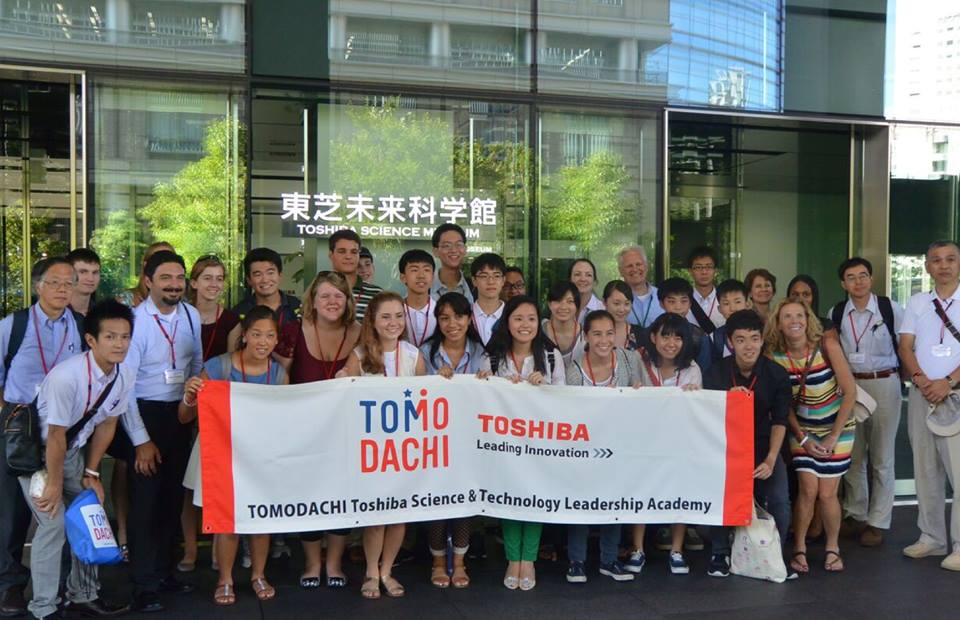The TOMODACHI Experience
By Guest Blogger
Posted on 2015-09-23
Over the course of a day, 350 million photos are uploaded to Facebook. 6,000 Tweets are sent each second, and young adults send or receive about 100 texts per day (hopefully not all of them during class time!). Together, this creates 2.5 quintillion bytes of data—so much that 90% of the data in the world today has been created in the last two years alone.
Along with creating data, our students will be asked to interpret and use the data in the workplace. How do we prepare them for this quickly changing future?
Leadership and Learning
In August, U.S. and Japanese teachers and students worked together at the TOMODACHI Toshiba Science & Technology Leadership Academy in Tokyo to practice learning experiences central to the Next Generation Science Standards (NGSS) and engineering design process. Members and leaders from the National Science Teachers Association (NSTA) were on hand to work with the students and gain new perspectives on science education.
Over the week, student teams were given two challenges: To design, build, and test a tower that could withstand a hurricane (wind from a fan), tsunami (water sprayed on the structure), and earthquake (the tower was on a base that was shaken on the test table), and to create a plan disaster resiliency plan for a city of the future.
The week was a mix of work, cultural experiences, and visits to museums and Toshiba sites. There wasn’t enough time for the American participants to be jet lagged!
As a teacher, things I learned were to not be afraid to challenge students with rigorous assignments, to give students scaffolding and support for these assignments, and to relate learning to the world around us.
The students worked hard. They were up at 7:00, busy by 8:00, and didn’t get excused for night often until 10 PM. Meals were sometimes eaten on a bus as we traveled across the city. At night, they were given new tasks to do. The students rose to the challenge, and seemed to thrive on the work.
The places we visited were carefully selected to both give us a cultural experience and to relate to the assignments. As we worked on the tower challenge, we visited Sky Tree Tower. At 634 meters tall, Sky Tree Tower is the tallest structure in Japan, and, at the time of its completion, the second tallest structure in the world. We met with Tower project engineers, and learned the details of the design and building of Sky Tree Tower. The Toshiba elevators in the Tower are alone worth a visit. Each is artfully designed to reflect the beauty of the seasons. The elevator engineering is remarkable. Traveling at speeds up to 600 meters per minute, the elevators move so smoothly that a quarter placed on its side at the start of the ride will still be standing on edge at the conclusion of the ride.
Back in the workroom, students thought back on the structure of Sky Tree Tower for inspiration in designing their own tower.
To get information about planning a disaster resilient city, we visited related sites.
We learned about using big data to build “smart” homes, cities, and businesses. The Toshiba Smart Home gives examples of how data can be used to make our lives comfortable. Imagine that your house will recognize each member of your family, and know what room temperature and light level each prefers. That’s what the Smart Home does. An LED light in the master bedroom can change color hues to enhance concentration when studying, wakefulness in the morning, and relaxation at night. I’d love to have these features in my house.
We visited the Disaster Preparedness Center and experienced hurricane force winds and rain, earthquake jolts, and simulated smoke from a fire. At the Toshiba Science Museum, we learned how technology has changed over time and may be used in the future.
By combining a feel for the impacts of natural disasters with information about how data can be used to make life more pleasant and efficient, students were given tools to use in their report planning.
Student teams were asked to describe how a city of the future could utilize technology and data to prepare for possible natural disasters. The teams presented their proposal to an audience that included the TOMODACHI group, Toshiba executives, NSTA Executive Director David Evans, Bill Nye, and representatives from the U.S. Japan Council and U.S. Embassy.
All students handled themselves with poise. Some Toshiba engineers took notes on the student ideas, showing that high school students can find solutions to big problems.
While the TOMODACHI Toshiba Science & Technology Leadership Academy experience included a unique chance to travel, the lessons learned can be applied in any classroom: challenge your students, give them tools for success, and you will see them thrive.
NSTA guest blogger Regina Brinker is a teacher on special assignment supporting STEM education. Brinker taught high school science/engineering through inquiry, creativity, and connections and now focuses on climate change, polar science, STEM careers, and PLTW engineering. Follow her on Twitter @brinkerscience.
The mission of NSTA is to promote excellence and innovation in science teaching and learning for all.
Follow NSTA
Disclaimer: The views expressed in this blog post are those of the author(s) and do not necessarily reflect the official position of the National Science Teaching Association (NSTA).






